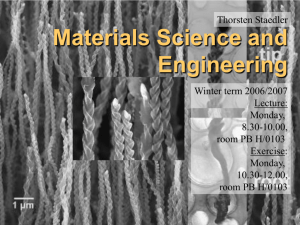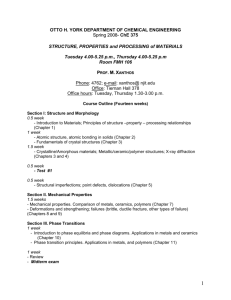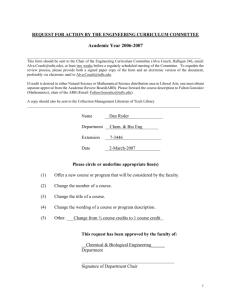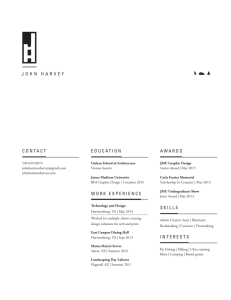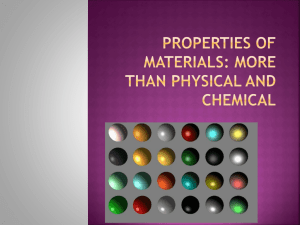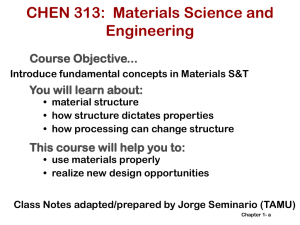Material Sciences
advertisement
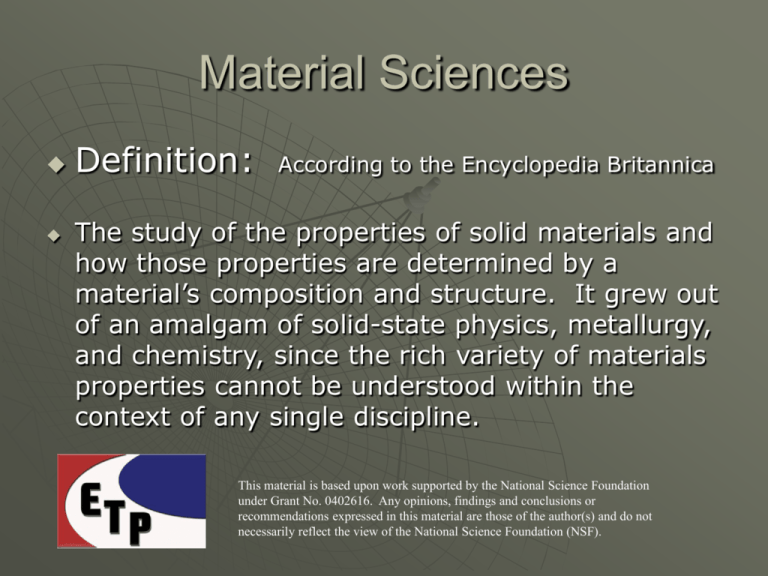
Material Sciences Definition: According to the Encyclopedia Britannica The study of the properties of solid materials and how those properties are determined by a material’s composition and structure. It grew out of an amalgam of solid-state physics, metallurgy, and chemistry, since the rich variety of materials properties cannot be understood within the context of any single discipline. This material is based upon work supported by the National Science Foundation under Grant No. 0402616. Any opinions, findings and conclusions or recommendations expressed in this material are those of the author(s) and do not necessarily reflect the view of the National Science Foundation (NSF). Material Sciences Engineers must have knowledge of the materials with which they work or they cannot design effective solutions to problems Material Sciences Materials science branches that we will discuss: • • • • • • • • Ceramics Metals and alloys Composites Polymers Crystals and semiconductors Superconductors Biosensors Nanotechnology Ceramics An artifact made of hard brittle material produced from nonmetallic minerals by firing at high temperatures. http://www.wordwebonline.com/en/CERAMICS Ceramics Long before humans had any knowledge of metals, there was a great interest in what we currently call ceramics in the form of pottery and brick building materials VCSU reading material Ceramics Ceramics are generally made by taking mixtures of clay, earthen elements, powders, and water and shaping them into desired forms. Once the ceramic has been shaped, it is fired in a high temperature oven known as a kiln. Often, ceramics are covered in decorative, waterproof, paint-like substances known as glazes. http://depts.washington.edu/matseed/mse_resources/Webpage/Ceramics/ceramics.htm Ceramics Ceramics are all around us. This category of materials includes things like tile, bricks, plates, glass, and toilets. Ceramics can be found in products like snow skies, automobiles (sparkplugs and ceramic engine parts found in racecars), and phone lines. They can also be found on space shuttles, appliances (enamel coatings), and airplanes (nose cones). http://depts.washington.edu/matseed/mse_resources/Webpage/Ceramics/ceramics.htm Ceramics Engineering Fields that may use ceramics are: • Aerospace • Mechanical • Chemical Ceramics Ceramic engineers and material scientists are currently working on ceramic ionic conductors that will be parts of high temperature batteries for automobiles. http://people.alfred.edu/~misture/nsf_k12/batteries.html Metals and Alloys A branch of study that comes to mind as the one with the longest history We often describe the history of mankind in terms of metals and alloys such as copper, bronze and iron. Metals and Alloys An alloy is a mixture of different metals that often have characteristics superior to any of the apparent materials Types of Alloys Steel Aluminum Magnesium Titanium Uses of alloys Aluminum alloys are used in aircraft construction because of its high strength/weight ratio, its corrosionresisting qualities, and its comparative ease of fabrication. http://www.tpub.com/air/1-24.htm Uses of alloys Titanium and its alloys have proven to be technically superior and costeffective in a wide variety of aerospace, industrial, marine and commercial applications. Examples of some uses: Aero-engines, dental, military hardware, and sporting equipment http://www.titaniuminfogroup.co.uk/titanium.htm Just about every field of engineering is going to use metals and alloys Here are just a few: • Aero space • Mechanical • Civil • Electrical Hot new items Titanium golf clubs and balls Composites Consist of two or more materials combined in such a way that the individual materials are easily distinguishable. http://composite.about.com/od/aboutcompositesplastics/l/aa060297.htm A common example of a composite is concrete. It consists of a binder (cement) and a reinforcement (gravel). Adding another reinforcement (rebar) transforms concrete into a three-phase composite. http://composite.about.com/od/aboutcompositesplastics/l/aa060297.htm Composites Concrete is used in the building of roads, and buildings mostly Many types of engineers use composites: Civil, Architectural Hot new product 1.Low Maintenance 2. Resists Heating & Fading 3.Safety 4.Durability 5.Increases The Value of Your Home Polymers a chemical compound or mixture of compounds formed by polymerization and consisting essentially of repeating structural units Polymerization a chemical reaction in which two or more molecules combine to form larger molecules that contain repeating structural units Polymers Polyvinylchloride (PVC); 1938. Thermoplastic polymer.-Used in pipes and fittings, wire and cable insulation, extruded film and sheet, and medical applications.-Its flexible grades are easy to process. Its rigid grades have a high dielectric strength, outdoor stability, chemical resistance, good moisture stability, and low cost. Both have low heat resistance.-Trade Name: Geon, Viclon. http://www.efunda.com/materials/polymers/history/history.cfm?list_order=time Polymers Polyethylene (PE); 1939. Thermoplastic polymer.-The largest volume commodity plastic, PE is used in blow-molded beverage bottles, auto gas tanks, and extruded pipe.-It has good toughness at low temperatures and is inexpensive.-Trade Name: Marlex, Alathon, Hostalen. http://www.efunda.com/materials/polymers/history/history.cfm?list_order=time Polymers Polystyrene (PS); 1930. Thermoplastic polymer.-Used for inexpensive packaging materials, pens, safety razors, flatware, and CD jewel boxes. In Styrofoam format, PS is used to make high-throughput, thin-walled, easyto-mold parts where structure is not paramount.-A material not structurally strong but easy to mold, it is inexpensive, machines well, and possesses excellent transparency.-Trade Name: Novacor 555. http://www.efunda.com/materials/polymers/history/history.cfm?list_order=time Polymers Many engineering fields use polymers a couple are: Industrial Mechanical Areospace Polymers Hot new products • Vinyl siding • Acrylic paints • Can be recycled from plastic bottles into building materials http://www.nationalgeographic.com/resources/ngo/education/plastics/ Semiconductors A material is a semiconductor if it is possible to reversibly vary the material's conductivity at a given temperature over several orders of magnitude using chemical or electrical means. N-type semiconductors have higher concentrations of conduction electrons. P-type semiconductors have lower concentrations of conduction electrons http://www.ee.calpoly.edu/~dbraun/courses/ee208/Define_semiconductor.html Semiconductors Semiconductors have had a monumental impact on our society. You find semiconductors at the heart of microprocessor chips as well as transistors . Anything that’s computerized or uses radio waves depends on semiconductors. http://www.howstuffworks.com/diode.htm Semiconductors Today, most semiconductor chips and transistors are created with silicon. You may have heard expressions like "Silicon Valley" and the "silicon economy," and that's why -- silicon is the heart of any electronic device. http://www.howstuffworks.com/diode.htm Semiconductors There are many fields of engineering that use semiconductors, anything computerized: Electrical Mechanical Aerospace Superconductors An element, inter-metallic alloy, or compound that will conduct electricity without resistance below a certain temperature Resistance is undesirable because it produces losses in the energy flowing through the material http://superconductors.org/INdex.htm Superconductors MRI magnetic resonance Imaging • Examine soft tissue such as cartilage, membranes, and brain tissue http://www.mse.cornell.edu/courses/engri111//mri.htm Superconductors Engineers that use superconductors • Mechanical • Electrical • Industrial • Chemical Superconductors Magnetic-levitation is an application where superconductors perform extremely well. Transport vehicles such as trains can be made to "float" on strong superconducting magnets, virtually eliminating friction between the train and its tracks. http://superconductors.org/Uses.htm New Product In December 2003, the MLX01 test vehicle (shown above) attained an incredible speed of 361 mph (581 kph). http://superconductors.org/Uses.htm Biosensors an apparatus that uses a biological agent such as an enzyme or organelle to detect, measure, or analyze chemicals. Biosensors are increasingly used in tests to diagnose medical conditions such as blood pressure. http://ca.encarta.msn.com/dictionary_1861590670/biosensor.html Biosensors Biosensors have been applied to a wide variety of analytical problems including in medicine, the environment, food, process industries, security and defense. http://srv.chim.unifi.it/ana/biosen.htm Biosensors Some of the fields of engineering that may use biosensors • Mechanical • Industrial • Agricultural • Electrical Biosensors Some monitor glucose in diabetic patients The US military created an undergarment that can provide data on a soldier’s injuries • Recognizes when and where a cut is and if it’s a vein or artery that was cut, depending on the oxygen levels http://www.ee.vt.edu/~jmentz/mse4206/applications.html Nanotechnology The ability to do things - measure, see, predict and make - on the scale of atoms and molecules The nanotechnology realm is defined as being between 0.1 and 100 nanometers A nanometer being one thousandth of a micron Which is, in turn, one thousandth of a millimeter . http://www.nanotechnologyinvestment.com/Companies/Nanotechnology/IndustryResearch.asp Nanotechnology Envisioned are all kinds of amazing products, including extraordinarily tiny computers that are very powerful, building materials that withstand earthquakes, advanced systems for drug delivery and custom-tailored pharmaceuticals as well as the elimination of invasive surgery, because repairs can be made from within the body. http://www.answers.com/nanotechnology&r=67 Nanotechnology Engineering fields that may use this: • Medical • Civil • Computer • Electrical • Aerospace Are just a few!!!! By 2020, scientists at Rutgers University believe that nanosized robots will be injected into the bloodstream and administer a drug directly to an infected cell. http://www.answers.com/nanotechnology&r=67 Standards and Benchmarks 2 CC 19M Q 3H J 7H K 10L
